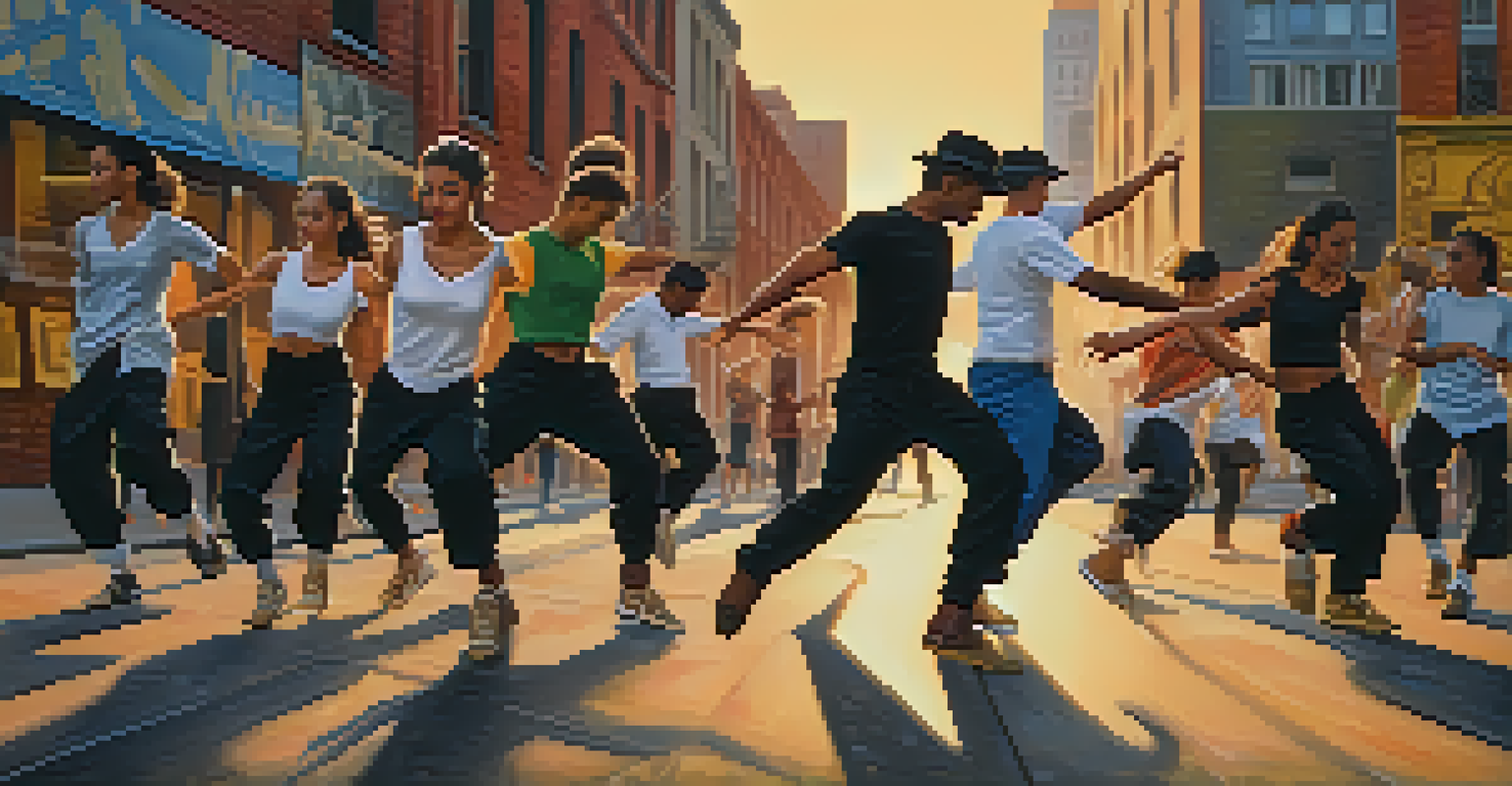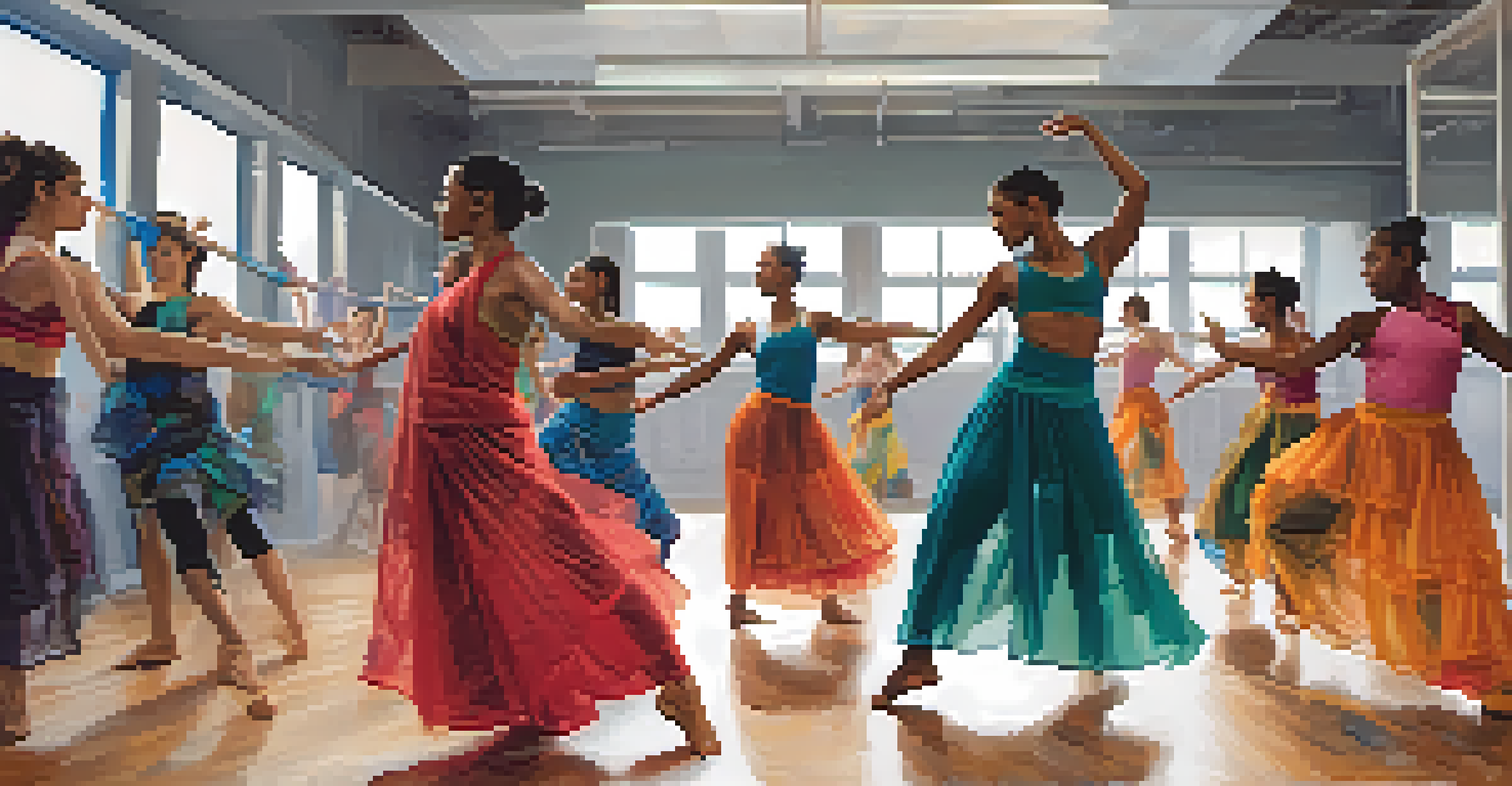The Impact of Folklore on Modern Dance Practices

Understanding Folklore in the Context of Dance
Folklore encompasses the traditions, stories, and cultural practices passed down through generations. In the realm of dance, it serves as a rich source of inspiration, providing dancers with narratives that resonate deeply with audiences. By integrating folklore into their performances, dancers can bridge the gap between past and present, creating a dialogue that celebrates cultural heritage.
Dance is the hidden language of the soul.
For instance, many traditional dances tell stories of community life, nature, or historical events. When modern dancers incorporate these elements, they not only pay homage to their roots but also invite viewers to engage with the narratives in new and exciting ways. This blending of old and new can evoke a sense of nostalgia while simultaneously encouraging innovation.
Furthermore, folklore in dance is not limited to a single culture; it incorporates a plethora of influences. This diversity enriches the dance landscape, allowing artists to experiment and create unique fusions that reflect a globalized world. In essence, folklore provides a foundational language for modern dance that transcends geographical boundaries.
How Folklore Shapes Dance Styles Today
Modern dance forms often draw from various folklore traditions, creating a unique fusion of styles. Dancers might incorporate movements from African tribal dances, Eastern European folk dances, or Native American ceremonial dances, each bringing its own cultural significance. This melding of styles not only enhances the visual appeal but also deepens the emotional connection of the performance.

For example, a contemporary dance piece may use the rhythmic footwork of Irish dance while integrating the expressive arm movements found in Indian classical dance. Such combinations showcase the versatility of modern dance and illustrate how folklore can breathe life into contemporary practices. Audiences are captivated not just by the skill but by the stories woven into each movement.
Folklore Inspires Modern Dance
Folklore serves as a rich source of inspiration for modern dancers, allowing them to blend traditional narratives with contemporary styles.
Moreover, choreographers often look to folklore for thematic inspiration, exploring universal themes like love, loss, and community. By grounding their work in these familiar narratives, they create approachable art that resonates with a wide range of viewers. This approach not only honors the original folklore but also allows for it to evolve within a modern context.
The Role of Cultural Identity in Dance
Cultural identity plays a significant role in how folklore influences modern dance. Dancers often seek to express their own backgrounds and experiences through the lens of traditional stories and movements. This personal connection can lead to performances that are both authentic and impactful, allowing audiences to witness the dancer's journey through their art.
Folklore is the living voice of the people.
For instance, a dancer of Latino descent may incorporate elements of salsa or flamenco into their contemporary work, reflecting their heritage while also making a broader statement about cultural pride. This practice not only celebrates individual identity but also highlights the importance of preserving cultural narratives in a rapidly changing world.
Additionally, as globalization continues to affect cultural exchanges, dancers are increasingly creating works that reflect hybrid identities. By blending folklore from different backgrounds, they foster a sense of belonging and shared experience, inviting audiences to appreciate the rich tapestry of human expression. This dynamic interplay of identities is a hallmark of modern dance.
Folklore in Collaborative Dance Projects
Collaborative dance projects often serve as a fertile ground for integrating folklore into modern practices. Dancers, choreographers, and cultural historians come together to explore traditional stories and movements, creating pieces that are informed by both historical context and contemporary relevance. These collaborations can result in innovative performances that challenge audiences' perceptions of folklore and its role in dance.
For instance, a project might involve dancers from different cultural backgrounds working together to create a piece that honors their respective heritages. The result is a layered narrative that speaks to the richness of diversity while celebrating the common threads that unite us. This collaboration not only enriches the dance but also fosters a sense of community among the artists involved.
Cultural Identity Shapes Performances
Dancers express their cultural identities through traditional stories and movements, creating authentic performances that resonate with audiences.
Moreover, these projects often engage the audience in a dialogue about the importance of preserving folklore in the modern age. By showcasing how traditional stories can inspire contemporary art, they encourage viewers to reflect on their own cultural backgrounds and the narratives that shape their identities. This engagement helps to sustain the relevance of folklore in today's society.
Influence of Technology on Folklore and Dance
In today's digital age, technology plays a significant role in how folklore is shared and interpreted within the dance community. Social media platforms, for instance, allow artists to showcase their work and connect with a global audience, creating opportunities for folklore to reach new heights. This accessibility can lead to a resurgence of interest in traditional dance forms and their stories.
Choreographers may also use technology to enhance their performances, incorporating multimedia elements that complement the folklore themes. For example, projections of traditional art or digital soundscapes can create an immersive experience that transports the audience into the world of the folklore being depicted. This fusion of technology and dance serves to modernize traditional practices while retaining their essence.
Furthermore, technology allows for the documentation and preservation of folklore practices that might otherwise be lost. Online archives and video recordings can serve as valuable resources for future generations of dancers and choreographers. This ensures that the rich tapestry of cultural narratives continues to inspire and inform modern dance.
Folklore as a Tool for Social Commentary
Folklore is often used in dance as a powerful tool for social commentary, addressing contemporary issues through the lens of traditional narratives. Dancers can reinterpret folklore stories to reflect modern challenges, using their art to spark discussions about identity, inequality, and cultural preservation. This approach allows folklore to remain relevant, providing a platform for critical conversations.
For example, a dance piece inspired by a traditional tale of struggle may be reimagined to comment on current societal issues such as migration or environmental concerns. By drawing parallels between the past and the present, dancers can highlight the ongoing relevance of these stories and the lessons they impart. This not only engages audiences intellectually but also emotionally.
Technology Enhances Folklore's Reach
The digital age enables the sharing and preservation of folklore in dance, ensuring that these cultural narratives continue to inspire future generations.
Moreover, using folklore in this way can empower marginalized voices, allowing them to reclaim their narratives and assert their identities. Dancers often find strength in their cultural stories, using them as a means of resistance and resilience. Through this artistic expression, folklore becomes not just a source of inspiration, but also a catalyst for change.
The Future of Folklore in Modern Dance
As we look to the future, the influence of folklore in modern dance shows no signs of waning. Dancers and choreographers continue to explore new ways to integrate traditional elements into their work, ensuring that these cultural narratives remain alive and vibrant. This ongoing exploration fosters an environment where innovation and respect for tradition coexist harmoniously.
The growing emphasis on cultural heritage and identity in the arts suggests that folklore will play an increasingly significant role in shaping the next generation of dancers. Young artists are more aware of the importance of their roots and are eager to incorporate them into their performances. This trend not only enriches the dance landscape but also encourages a sense of continuity within the art form.

Ultimately, the future of folklore in modern dance promises to be a dynamic interplay of tradition and innovation. As dancers continue to draw inspiration from their cultural narratives, they will shape a dance landscape that is both reflective of the past and forward-thinking. In this way, folklore will remain a vital source of creativity, connection, and cultural expression for years to come.